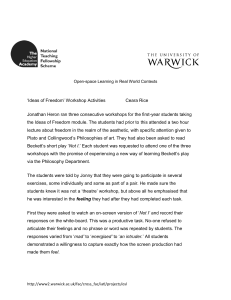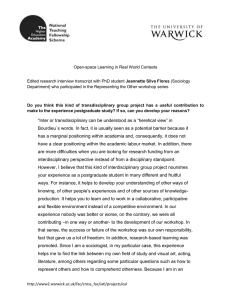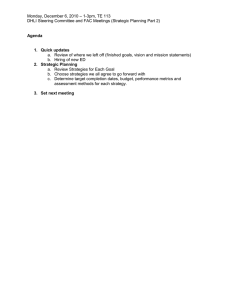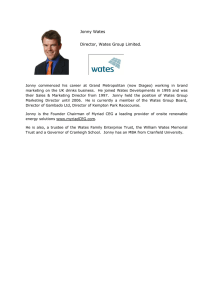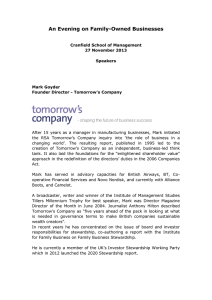‘Ideas of Freedom’ Workshop Activities ... Jonny Heron ran three consecutive workshops for the first-year students...
advertisement
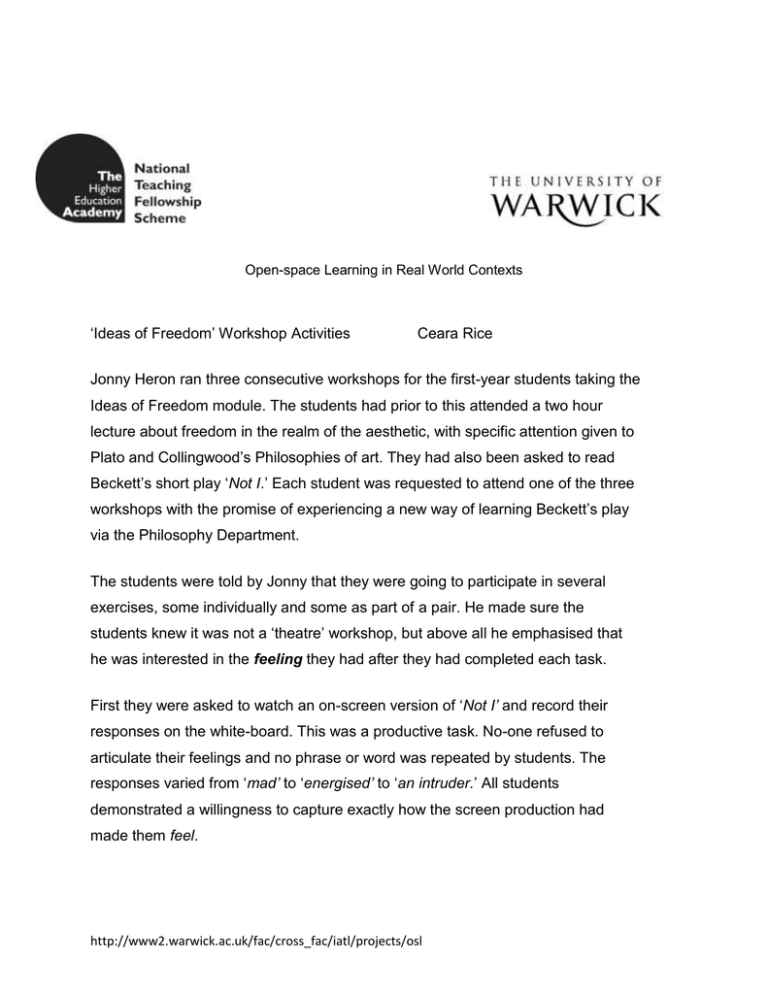
Open-space Learning in Real World Contexts ‘Ideas of Freedom’ Workshop Activities Ceara Rice Jonny Heron ran three consecutive workshops for the first-year students taking the Ideas of Freedom module. The students had prior to this attended a two hour lecture about freedom in the realm of the aesthetic, with specific attention given to Plato and Collingwood’s Philosophies of art. They had also been asked to read Beckett’s short play ‘Not I.’ Each student was requested to attend one of the three workshops with the promise of experiencing a new way of learning Beckett’s play via the Philosophy Department. The students were told by Jonny that they were going to participate in several exercises, some individually and some as part of a pair. He made sure the students knew it was not a ‘theatre’ workshop, but above all he emphasised that he was interested in the feeling they had after they had completed each task. First they were asked to watch an on-screen version of ‘Not I’ and record their responses on the white-board. This was a productive task. No-one refused to articulate their feelings and no phrase or word was repeated by students. The responses varied from ‘mad’ to ‘energised’ to ‘an intruder.’ All students demonstrated a willingness to capture exactly how the screen production had made them feel. http://www2.warwick.ac.uk/fac/cross_fac/iatl/projects/osl Jonathan then moved on to a second introductory exercise. He asked the students to read five quotes either from or about Beckett and stand beside the one that interested them the most. Splitting in to groups he asked them to express to the room why they were interested by their particular quote. Once again the responses were well thought out and engaging. Most students were interested in the idea that there is no right or wrong answer to questions of art. They felt much of what we read is ultimately determined by interpretation. This attitude was particularly encouraging considering the new style of learning in which the students were currently participating. They demonstrated an open-mind to different perspectives concerning the meaning of art, all acknowledging that failure could still be a productive result for an artist. We then moved on to a more practical exercise. The students were asked to explore the scale of expression they were able to put in their voices when speaking continuously. Everyone picked a topic they were confident they could speak on, without pausing, for at least a minute and then when Jonny said ‘go’ they were all to begin speaking at once. No specific voice could be distinguished from anyone else’s. When they were asked to stop and Jonny asked them how that felt, the students initially responded with ‘silly’ and that they were only ‘speaking for the sake of speaking...there was no direction or end to why you’re speaking.’ When they were then asked to speak using the same method of continuous dialogue but with a much more expressive tone, the responses of the students were more interesting. They seemed to feel that the words lost their meaning when Jonny had asked them to speak with an enthusiasm they did not necessarily feel about their topic of choice. It required a lot more effort and concentration to maintain such a level of expression. It became ‘almost a performance,’ something distanced from their selves. However, when they were then asked to place as little expression as possible in their voice, the majority of students had a more positive response to the task, http://www2.warwick.ac.uk/fac/cross_fac/iatl/projects/osl claiming it was ‘easier’ to do and was perhaps more ‘authentic.’ When they lost the performative aspect of speech they felt their words become much more reflective allowing them to focus on the meaning of what they were saying. To compare the difference the students then were asked to read from a portion of ‘Not I’ and explore scale of expression in reading another person’s thoughts. This helped them return to the text and apply the skills Jonny had been teaching them to the specific play they were studying. The students seemed to enjoy this, yet found it strange ‘reading her stream of consciousness’ and trying to second-guess where the speaker would ordinarily place their own inflections and emphasis. This showed the students the difficulty in the interaction between the actor and the character that actor is playing. It left the students with thoughts about ‘Not I’ and the relationship between the mouth and the auditor. As a final task Jonny asked the students to split in pairs and think about a static pose that represents this relationship between the mouth and auditor. With just their bodies each pair came up with several different images: some faced each other, some were pulling each other and some were not touching at all. As we were coming to the end of the workshop Jonny asked each pair to quickly come up with another static image this time to represent the dialogue between Ion and Socrates in Plato’s ‘Ion,’ a text all the students were also studying. Like before each pair came up with very different poses, but this time there was some disagreement over which person was representing which character. Some pairs had interpreted Socrates as the dominating force, whereas others had interpreted Ion as the dominating force. This surmised very well the first idea that the students discussed. This being that art is an interpretive medium. There is no right or wrong answer; there is just what you feel about a work. http://www2.warwick.ac.uk/fac/cross_fac/iatl/projects/osl
